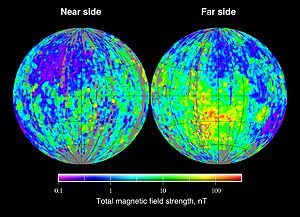Magnetic field of the Moon

The magnetic field of the Moon is very weak in comparison to
One hypothesis holds that the crustal magnetizations were acquired early in lunar history when a geodynamo was still operating. An analysis of magnetized
It is possible that on an airless body such as the Moon, transient magnetic fields could be generated during large impact events. In particular, study of Apollo impact glass associated with a young, 2 million-year-old crater has yielded a strong magnetization comparable in strength to Earth's magnetic field[5]. This magnetization could not have originated in the lunar core, but is instead consistent with predictions from fields associated with impact plasmas[5].[7] These observations have led to the hypothesis that prior reports of high paleofield strengths from Apollo samples record impacts, not a core dynamo[5,6]. Importantly, the lack of a long-lasting lunar dynamo and paleomagnetosphere should have allowed 3He, water, and other volatile resources acquired from solar winds and Earth’s magnetosphere over some 4 billion years to accumulate in lunar soils [5,6].
It has also been noted that the largest crustal magnetizations appear to be located near the
There is growing evidence that fine particles of
The plasma sheet is a very dynamic structure, in a constant state of motion, so as the Moon orbits through the magnetotail the plasma sheet can sweep across it many times with encounters lasting anywhere from minutes to hours or even days.[12]
In fiction
In the
See also
- Gravity field of the Moon
- Topography of the Moon
References
- ^ Crane, Leah. "Moon's magnetic field lasted twice as long as we thought it did". New Scientist. Retrieved 2020-01-02.
- ^ "Apollo 11 Lunar Surface Magnetometer Experiment". www.lpi.usra.edu. Retrieved 2021-08-11.
- ^ Wieczorek, Mark; Jolliff, Bradley; Khan, Amir; et al. (2006). The Constitution and Structure of the Lunar Interior. mineralogical society of America. p. 314.
- ^ Yeager, Ashley (2017-08-09). "Moon had a magnetic field for at least a billion years longer than thought". Science News. Retrieved 2017-08-10.
- PMID 34348904.
- ^ Tarduno, JA. "Moon lacked a magnetic field for nearly all its history – new research resolves mystery sparked by rocks brought back on Apollo". The Conversation. Retrieved 7 September 2021.
- S2CID 213041057. Retrieved 7 September 2021.
- doi:10.1029/91JB00308.)
{{cite journal}}: CS1 maint: multiple names: authors list (link - .
- NASAspaceflight.com. Retrieved 8 September 2013.
- ^ NASA, Dwayne Brown (August 2013). "Lunar Atmosphere and Dust Environment Explorer (LADEE) - Press Kit" (PDF). Retrieved 2013-09-08.
- ^ NASA – The Moon and the Magnetotail
- ISBN 9780253213907.

